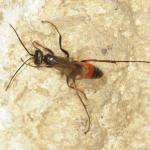A medium-sized red and black species, the female usually with red-marked legs. It belongs to the subgenus Priocnemis sens. str., which includes some of the most difficult species to identify accurately. Amongst this group, the female of agilis is one of the better characterised species. The male may be confidently identified by reference to the genitalia.
A local species with the majority of records restricted to southern England. There are a few isolated records from much further north in Scotland. Also known from the Channel Islands.
Overseas it occurs through Europe, although it is rare in the south (Wolf, 1972). France, Belgium, Italy, Switzerland, Germany, Denmark, Austria, Czech Republic, Slovakia, Poland, Romania, Albania, Cyprus and Finland (Wahis, 2011).
This species was listed by Falk (1991) as Notable B (now known as Nationally Scarce Nb).
It is a species of open, dry, warm situations, apparently without regard to underlying geology.
Occurring from May to October, although the majority of records are from late July into September.
Due to confusion with similar species, earlier prey records should be regarded as unreliable. Falk (1991) refers to an unpublished observation by Spooner of the spider Drassodes (Gnaphosidae) as prey. These spiders are nocturnal, hiding under stones or loose bark during the day.
Nothing is known of the nesting biology. Most Priocnemis are fossorial nesters, creating multilocular nests often in pre-existing cavities.
Day (1988) gives it as being attracted to wild carrot.
2012


